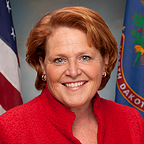Learning Firsthand about Challenges and Opportunities in the Arctic Region
Last week, I returned from a three-day, official, bipartisan U.S. Senate trip across the Arctic, visiting Norway, Greenland, and Alaska to learn about U.S. energy and national security interests in the region firsthand.
My friend and the chair of the U.S. Senate Energy Committee, Republican U.S. Senator Lisa Murkowski from Alaska, led the trip. U.S. Secretary of the Interior Ryan Zinke and U.S. Senators John Barrasso (R-WY), John Cornyn (R-TX), and Steve Daines (R-MT) were also on the trip.
As the Arctic opens up, it’s more and more pressing to understand this region from an energy and a national security standpoint. That was the goal of this bipartisan trip — to see firsthand the challenges and opportunities the United States faces in the region. Whether it was hearing directly from U.S. Marines training to fight in Arctic conditions, or seeing the oil and natural gas potential in Alaska and Norway up close, each day was an opportunity to better understand a region that is becoming more central to our security by the day. The trip also reinforced the importance of Air Force Arctic missions, which I’ve pushed the Air Force to consider Grand Forks for given its strength in remotely piloted aircraft and proximity to the Arctic.
We first stopped in Hammerfest, Norway — 600 miles above the Arctic Circle — to visit Europe’s largest liquefied natural gas (LNG) facility.
We also met with Norwegian officials and discussed how the local economy has benefited from LNG development in the area.
This visit was particularly interesting because it was directly related to years of meetings I’ve had since joining the U.S. Senate to strengthen ties with Norwegian officials and Norwegian energy companies that are some of the most innovative in the world.
The next stop in Norway was Vaernes Air Station to have breakfast with U.S. Marines from Camp Lejeune, North Carolina.
These servicemembers have been stationed in Norway since January as part of the Marine Rotational Force-Europe — a program aimed at improving Marines’ fighting abilities in the Arctic conditions and promoting strong NATO ties.
After Vaernes Air Station, we traveled to Thule Air Force Base in Greenland — which features a 10,000-foot runway and a deepwater port.
I’ve been doing a lot of work to make sure the U.S. has a robust strategy for dealing with challenges and opportunities in the Arctic so it was great to talk with folks on the ground in Greenland. The feedback I heard from our brave men and women on the ground will be useful as I continue to work with Congress and the U.S. Department of Defense to highlight the important role the Arctic region plays in protecting our national security — including at Grand Forks Air Force Base.
Our last stop was Deadhorse, Alaska to review the Trans-Alaska Pipeline System.
After learning from the pipeline’s operators about challenges it faces and the oil resources in the region, we went to the National Petroleum Reserve-Alaska to see North Slope oil development.
After years of working with folks in North Dakota and Washington, D.C. to better understand the Arctic region from energy and national security standpoints, it was important to see it firsthand. I’m eager to take what I learned and saw in Norway, Greenland, and Alaska to continue to reinforce the importance of Arctic missions.
